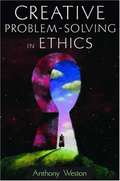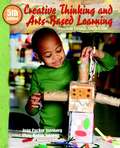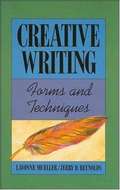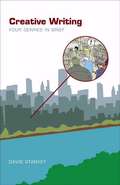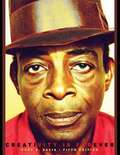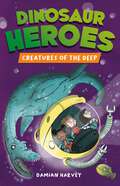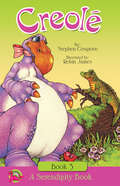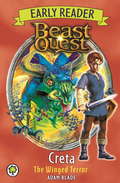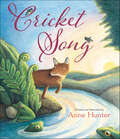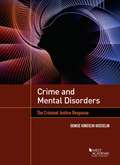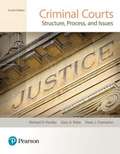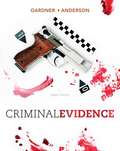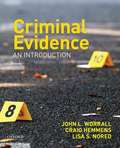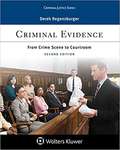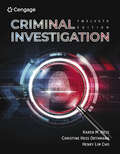- Table View
- List View
Creative Living: Basic Concepts in Home Economics (Third Edition)
by Josephine A. FosterYou probably spend a lot of time thinking about how other people see you. Maybe you have a hard time figuring out who you are and how you should act. You might be good at making people laugh. But one or two-people think that you're a show-off. Or maybe you're quiet.
Creative Problem-Solving In Ethics
by Anthony WestonA readable and insightful guide to ethical dilemmas.
Creative Speaking (2nd edition)
by David A. FrankThis new and completely revised edition of Creative Speaking is designed to provide succinct, comprehensive guidance for those preparing for individual speech events. This book can also be used as a textbook for advanced speech courses designed to give students practical experience in all of the various forms of speech making.
Creative Thinking and Arts-Based Learning:Preschool Through Fourth Grade (5th Edition)
by Joan Packer Isenberg Mary Renck JalongoThe fifth edition of this book shows future and current early childhood educators how to integrate children's creativity, play, and the arts into their curriculum in a way that fosters learning and growth and meets accountability measures.
Creative Writing
by Lavonne Mueller Jerry D. Reynolds'Creative Writing' takes writers through all the steps--from keeping a writer's journal to submitting manuscripts for publication. In an exciting format featuring numerous examples from student and professional writing, 'Creative Writing' presents techniques and tips for writing poetry, fiction, drama, and journalism.
Creative Writing: Four Genres in Brief
by David StarkeyHow can students with widely varied levels of literary experience learn to write poetry, fiction, creative nonfiction, and drama -- over the course of only one semester? In Creative Writing: Four Genres in Brief, David Starkey offers some solutions to the challenges of teaching the introductory creative writing course: (1) concise, accessible instruction in literary basics; (2) short models of literature to analyze, admire and emulate; (3) inventive and imaginative assignments that inspire and motivate.
Creativity 101 (Psych 101)
by James C. KaufmanCreativity 101, describes the history of how people began to study creativity and discusses different definitions. It explores the "Four P's" (person, process, product, and press).
Creativity Is Forever (5th edition)
by Gary A. DavisThis book was prepared for any adult interested in better understanding the topic of creativity, becoming a more creative person, or teaching others to think more creatively. It is true that much about human creativity remains---and will remain---an intriguing mystery. It is difficult indeed to untangle the drives, thoughts images, and inspirations of a Thomas Edison, Georgia O'Keeffe, or Walt Disney. As we will see in Chapter 3, extraordinarily creative people have not understood their own creativeness. However, it also is absolutely true that we do understand much about creativity and creative people---their energetic and curious personalities, their ideas--finding processes and strategies, and the circumstances that support or squelch their lively imaginations and innovative thinking.
Creature Camouflage (Fountas & Pinnell Classroom, Guided Reading)
by Mia LewisNIMAC-sourced textbook
Creature Features: Exploring Animal Characteristics (Into Reading, Level V #86)
by Lisa RaoNIMAC-sourced textbook. Learn all about the differences between amphibians, reptiles, mammals, and more! This book explores the coolest creatures and the features that make them special.
Creatures of the Deep (Dinosaur Heroes)
by Damian HarveyJoin our team of Heroes in this fast-paced, dinosaur-themed chapter book as they undertake a daring seep sea rescue to locate a missing submersible ...Great for readers age 7+ these adventure stories are also full of fascinating facts about dinosaurs.These illustrated chapter books are perfect for bringing dinsoaur and science facts to young readers, inspiring a thirst for knowledge and learning by stealth. The team of characters come from around the world to give a truly global outlook, too.
Crecer como un abenaki: Como se lo contaron a Pat Cusick (¡Arriba la Lectura!, Level N #40)
by Joseph Bruchac Ann BarrowNIMAC-sourced textbook. Cuando era un jovencito que vivía cerca de las montañas de Adirondack, Joseph Brucach no sabía que tenía raíces indígenas americanas. ¿Cómo las descubrió? ¿Cómo llegó a convertirse en un narrador abenaki?
Crecer, crecer, crecer: Funciones exponenciales
by Glenda Lappan James T. Fey Susan N. Friel Elizabeth Difanis PhillipsNIMAC-sourced textbook
Creepers in the Corn (Fountas & Pinnell Classroom, Guided Reading)
by Robert Squier Pat SchmatzAre there really scary creepers in the cornfield, as Audrey's brother claims? Looks like she's going to find out!
Creole
by Stephen Cosgrove Robin JamesCreole is a unique creature who lives alone in the swamp. She lives alone because the other creatures that live there are frightened by her looks. Looks can be deceiving and so can judging a book by its cover. Ages 5-9.
Creta the Winged Terror (Beast Quest Early Reader #4)
by Adam BladeEvil Wizard Malvel has conjured up Creta, a terrifying monster that can unleash thousands of vicious insects from its body! Can Tom defeat Creta before the Beast destroys the whole kingdom?Beast Quest Early Readers are perfect for children learning to read and for families to enjoy together, with text vetted by a literacy expert and bright new colour illustrations.Also available: Beast Quest Early Reader 3: Arax the Soul Stealer!
Cricket Song
by Anne HunterA poignant and beautiful bedtime book, Cricket Song connects two children on different continents through the evocation of sound and smell. Readers will love identifying various creatures portrayed in the book and watching what they are doing as the two children begin to fall to sleep in their beds on seemingly opposite sides of the world. While differences between cultures may be obvious, ultimately, this lovely story of sleep is a tale about interconnection.
Crime And Mental Disorders: The Criminal Justice Response (Higher Education Coursebook)
by Denise Gosselin<p>The newest entry in the cutting edge topic of Mental Illness and Crime, this book from Denise Gosselin is practically focused and straightforward in its approach. It's clear, concise writing style avoids jargon and will engage both undergraduate and graduate students. It includes discussions of understanding mental illness, the changing landscape of criminal justice and mental illness, criminal justice responses to mental illness, alternatives to incarceration and global issues. An accompanying website includes Test Banks and other instructional materials. <p>Organized into five sections: <p> <li>Part I UNDERSTANDING MENTAL ILLNESS concern the history (past and present), classifications, and introduction to the criminal justice issues on the responses to people with mental illness. <li>Part II THE CHANGING LANDSCAPE examines the criminal justice involved encounters that occur outside of the traditional system, involving intervention, collaboration, and civil commitment. <li>Part III CRIMINAL JUSTICE RESPONSES look at law and policy of law enforcement, the criminal court and corrections. <li>Part IV ALTERNATIVES TO INCARCERATION reflects recent changes to reentry and community corrections. The juvenile justice component includes the brief system responses to juveniles with mental disorders. <li>Part V GLOBAL ISSUES stands alone as chapter 14 to remind us that we are not alone! The issues and system responses are not unique to the United States. </li> </p>
Criminal Courts: Structure, Process, And Issues
by Richard Hartley Gary Rabe Dean ChampionFrom the actors in the system, including judges, prosecutors, and defense attorneys, through the sentencing and appeals process, Criminal Courts provides comprehensive coverage of the United States Criminal Court systems in a succinct, readable approach. It examines issues confronting the system from historical, philosophical, sociological, and psychological perspectives, and throughout there are comparisons of court ideals with what actually happens in the courts. Comprehensive coverage of the processing of offenders from when they are arrested and charged with crimes, to when they are convicted and sentenced is presented, and throughout the text, practical, real-life applications of the topics and issues give the material meaning. Included to enhance learning are: evidence-based chapter openings that provide context to the chapter's material, boxes that discuss relevant case law, chapter summaries to reiterate the chapter learning objectives, and policy-oriented critical thinking exercises based on current issues facing the system.
Criminal Evidence (Eighth Edition)
by Terry Anderson Thomas GardnerWhat makes evidence admissible or inadmissible in court? You'll know the answer once you read CRIMINAL EVIDENCE: PRINCIPLES AND CASES, 8th Edition. Whatever your future career in the justice system, this book outlines all you need to know about criminal evidence and its use. Packed with stories and cases as well as the most up-to-date legal information available, it's the most relevant and engaging resource of its kind.
Criminal Evidence: An Introduction
by Craig Hemmens John Worrall Lisa Nored<p>Criminal Evidence: An Introduction, Third Edition, provides comprehensive and applied coverage of the rules of evidence, along with numerous case excerpts that clearly illustrate those rules. Using engaging, straightforward language, authors John L. Worrall, Craig Hemmens, and Lisa S. Nored offer an invaluable and innovative resource for both students and instructors. <p>Concentrating on the Federal Rules of Evidence, this distinctive text presents in-depth yet accessible coverage of evidentiary law in fourteen succinct chapters. To draw students into this complex subject, the authors explain criminal evidence through a unique blend of text and case excerpts; throughout, these excerpts illuminate the rules in useful, fascinating, and often unusual examples.</p>
Criminal Evidence: From Crime Scene To Courtroom (Aspen Criminal Justice Series)
by Derek RegensburgerWith lucid text, four-color illustrations, and abundant examples, Criminal Evidence: From Crime Scene to Courtroom, Second Edition, follows the path of evidence throughout the criminal justice process. Derek offers a clear introduction to the principles of evidence and instructions for collecting, preserving, and presenting evidence in a criminal case. Actual trials and news excerpts bring the material to life as they illustrate the role of evidence in real cases. Online videos of mock trial scenes reinforce students’ understanding of key concepts covered in the book.
Criminal Investigation
by Kären M. Hess Christine Hess OrthmannThis text stresses the practical procedures, techniques, and applications of private and public investigations to provide students with a solid foundation in criminal investigation. The Sixth Edition emphasizes professionalism and integrates coverage of modern investigation tools as it presents established investigation policies, procedures, and techniques for the law enforcement officer. Recent court cases; coverage of the latest investigative techniques and technology; and new material on topics such as domestic violence, stalking, and child abuse enhance the text's practical and applied approach.
Criminal Investigation
by Christine Hess Orthmann Kären Matison Hess Henry Lim Cho Jennifer Molan ChoMaster modern investigative principles and practices using the field-based approach strongly grounded in current research with Hess/Hess Orthmann/Cho/Molan's CRIMINAL INVESTIGATION, 12E. This best-selling text introduces established tools, practices and policies while detailing the latest innovations in investigative technology and science today. The authors clearly demonstrate techniques and practical applications using a captivating, reader-friendly presentation. The latest discussions introduce advancements in DNA evidence, incident review and solvability factors, terrorism and homeland security, electronic data searches, new case law, forensics and physical evidence, use of body cameras, and ethics as well as increasing standards of proof for stop versus search and arrest versus conviction. MindTap digital resources help you refine your skills and strengthen your understanding with video cases, career scenarios, chapter quizzes and interactive labs that explore investigative techniques.

